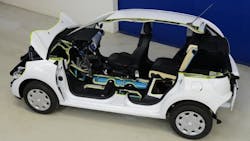An air car? No way. A hybrid air car? Maybe.
Unless some sort of major breakthrough occurs, cars powered only by compressed air just can't be practical. Conventional cars, or course, store the potential energy of gasoline, which can propel a 3,000 lb vehicle for 400 miles or more. For most people, that will last a week or more between fillups. You can also cruise at speeds of 60 mph or more and get high acceleration when you need it. That's a far cry from the Tin Lizzies of 100 years ago.
It's also a far cry from today's electric cars. Electric cars don't provide much more perfomance than they did 100 years ago. Using the latest technology in batteries can yield some decent acceleration, but the range of electrics is still only about 120 miles. So if you want to drive from Cleveland to Cincinnati (roughly 250 miles), you'll have to stop to recharge the batteries twice during your trip — and even more if you use air conditioning, heater, or headlights.
Air cars are no better. There's only so much compressed air energy a vehicle can store — and it's nowhere near that of 20 gal of gas. With their range of maybe 100 miles, compressed air cars are only practical for going back and forth to work (if you live 25 miles or less from where you work) and for local trips. If you want to go cross country, you'll have to stop frequently to recharge the compressed air supply.
Whether they're electric or air cars, these vehicles seem like only sophisticated golf carts. In fact, it almost sounds like they revert back to the steam age. When steam locomotives ruled the rails, you could travel from Boston to LA, but you had to stop frequently to replenish fuel, water, or both. Don't get me wrong, I'm all for finding alternative energy to reduce harmful effects on the environment. But this discussion is about alternative drives.
Another interesting aspect of this vehicle is its variable transmission, which provides high torque for acceleration at low speed and also lets the engine run economically at highway speeds. In this case, the transmission is hydraulic, rather than the series of gears used in a manual transmission or the hydrodynamic system used in automatic transmssions. Sounds like a topic for future coverage.
In conclusion, I'm not claiming that all-electric or all-air cars can't work. They certainly can, but widespread use will require Americans to alter the way they use their cars. That's about as likely as the US standardizing on the metric system.
About the Author
Alan Hitchcox Blog
Editor in Chief
Alan joined Hydraulics & Pneumatics in 1987 with experience as a technical magazine editor and in industrial sales. He graduated with a BS in engineering technology from Franklin University and has also worked as a mechanic and service coordinator. He has taken technical courses in fluid power and electronic and digital control at the Milwaukee School of Engineering and the University of Wisconsin and has served on numerous industry committees.

Leaders relevant to this article:







